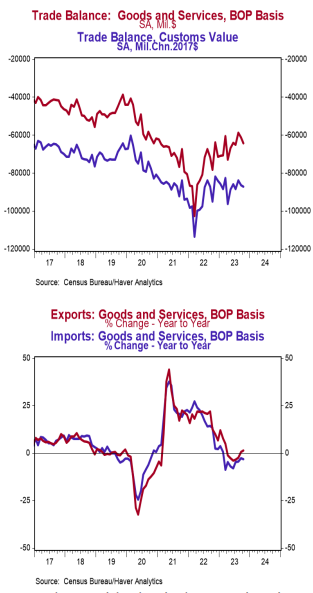- The trade deficit in goods and services came in at $64.3 billion in October, almost exactly the consensus expected $64.2 billion.
- Exports declined by $2.6 billion, led by autos, civilian aircraft, and gem diamonds. Imports rose by $0.5 billion, led by pharmaceuticals, computers, and drilling & oilfield equipment.
- In the last year, exports are up 1.3% while imports are down 3.2%.
- Compared to a year ago, the monthly trade deficit is $14.0 billion smaller; after adjusting for inflation, the “real” trade deficit in goods is $8.0 billion smaller than a year ago. The “real” change is the trade indicator most important for measuring real GDP.
Implications: The trade deficit in goods and services grew to $64.3 billion in October as imports grew and exports declined. However, we prefer to focus on the total volume of trade, imports plus exports, as it shows the extent of business and consumer interaction across the US border. After exploding higher in September, this measure pulled back in October, falling by $2.1 billion, and still remains down 1.3% from a year ago. Exports are only up 1.3% versus a year ago, while imports are still down 3.2%, consistent with our forecast that the US is headed toward a recession. And while a recent surge in the federal budget deficit might have helped the US economy avoid recession in the short-term, this kind of artificial support can’t last. Notably, there is a major shift going on in the pattern of US trade. So far this year, imports from China are down 22.6% year-to-date versus the same timeframe in 2022. China used to be the top exporter to the US. Now the top spot is held by Mexico, with Canada and China flip flopping month by month between second and third. Meanwhile, daily freight rates have fallen rapidly and are back down to pre-COVID levels, or lower, as demand for shipping has also weakened. This was confirmed by the New York Fed’s Global Supply Chain Pressure Index in October, with the index staying in negative territory, 0.39 standard deviations below the index’s historical average. Weaker demand coupled with an easing of parts shortages and less shipping congestion have pulled the indicator lower. Also in today’s report, the dollar value of US petroleum exports exceeding imports once again. This marks the 20th consecutive month of the US being a net exporter of petroleum products. In other news today on the labor front, ADP’s measure of private payrolls increased 103,000 in November versus a consensus expected 130,000. We expect Friday’s payroll report to show a nonfarm payroll gain of 190,000.





